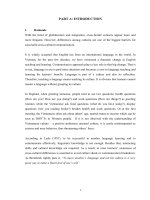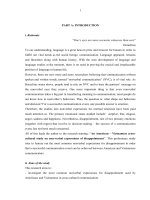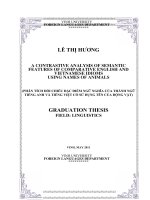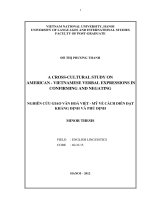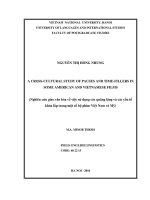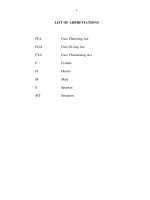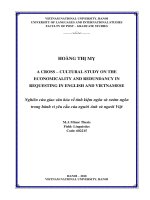an english - vietnamese cross - cultural study of boasting = nghiên cứu giao văn hóa việt - anh trong cách khoe khoang
Bạn đang xem bản rút gọn của tài liệu. Xem và tải ngay bản đầy đủ của tài liệu tại đây (721.23 KB, 50 trang )
4
TABLE OF CONTENTS
* Certificate of originality of study project report
*Acknowledgements
*Abstract
*Table of contents
*Abbreviations
* List of tables
* List of figures
i
ii
iii
iv
vi
vii
viii
PART I: INTRODUCTION
1. Rationale
2. Scope of the study
3. Aims of the study
4. Methodology
5. Design of the study
PART II: DEVELOPMENT
CHAPTER 1: THEORETICAL BACKGROUND
1.1. Language, culture and cross-cultural communication
1.1.1. Language, culture in communication
1.1.2. Language and culture in cross-cultural communication
1.2. Speech act
1.2.1. What is a speech act?
1.2.2. Classification of speech acts
1.2.3. Boasting as a speech acts
1.3. Politeness
1.3.1. What is politeness?
1
1
2
2
3
3
5
5
5
5
6
7
7
8
10
11
11
5
1.3.2. Face and Politeness
1.3.3. Politeness strategies
CHAPTER 2: DATA ANALYSIS AND FINDINGS
2.1. Advisable topics to boast
2.2. Politeness strategies realized in boasting
2.3. Use of strategies in boasting as seen from communicating
partners' parameters
2.3.1. Data analysis
2.3.2 Major similarities and differences
2.4. Use of strategies in boasting as seen from informants'
parameters
2.4.1. Data analysis
2.4.2 Major similarities and differences
PART III: CONCLUSION
1. Review of the findings
2. Implications for cross – cultural communication
3. Suggestions for further research
REFERENCES
APPENDICES
12
14
16
16
18
20
20
28
28
29
31
33
33
33
33
35
6
ABBREVIATIONS
DCT: Discourse Completion Task
FTA: Face Threatening Act
H: the Hearer
S: the Speaker
LIST OF TABLES
7
Table 1: The five general functions of speech acts (following Searle, 1969)
Table 2: Favourable topics of boasting
Table 3: Politeness strategies according to the parameter of age
Table 4: Politeness strategies according to the parameter of gender
Table 5: Politeness strategies according to the parameter of marital status
Table 6: Politeness strategies according to the parameter of living place
LIST OF FIGURES
Figure 1: Politeness strategies in boasting to Close friend
Figure 2: Politeness strategies in boasting to a person you dislike
8
Figure 3: Politeness strategies in boasting to Colleague (same age, same sex)
Figure 4: Politeness strategies in boasting to Colleague (same age, opposite sex)
Figure 5: Politeness strategies in boasting to Acquaintance (older than you)
Figure 6: Politeness strategies in boasting to Acquaintance (younger than you)
Figure 7: Politeness strategies in boasting to Brother/sister
Figure 8: Politeness strategies in boasting to Aunt/uncle
Figure 9: Politeness strategies in boasting to Boss (older than you)
Figure 10: Politeness strategies in boasting to Boss (younger than you)
PART I: INTRODUCTION
1. RATIONALE
9
Nowadays, as English becomes an international language in many fields, the
number of Vietnamese learners of English has increased. However, it is recognized that
many Vietnamese – English interactions have experienced communication breakdown
due to misinterpretations and misunderstandings.
Language plays an important role in our life. Language is not only for
communication but also for cultural exchange among nations. It is difficult to imagine
what our lives would be like without language. Language is a sign that makes human
different from all other species in the animal kingdom. People use it to communicate their
ideas and thoughts to express their feelings such as anger, love, hate… and to convey
their hopes and dreams.
Cross – cultural communication is an interesting and attractive field for us to find
out the similar and different language when studying speech acts such as greeting,
advising, promising among countries in the world. Comparisons of speech acts from
different cultures have revealed that the same speech acts may be realized differently
across cultures, following social norms of usage which are specific to the given speech
community.
In real – life conversations, people show different aspects of lives through
diversified formal and informal speech. Among them, lots of people can’t wait to tell us
all how fantastic they are, how they are good at this and even better than that. They claim
all manner of wild and outrageous things. They may claim to be enlightened, wise, highly
intellectual and they might tell you that they are so popular that you should be honored
they chose you to spend their day with. This is the way people boast and big themselves
up.
In the process of learning a foreign language, learners of English have to get to
know a different culture. They sooner or later realize the presence of cross – cultural
differences between English and Vietnamese. There were many studies about how
English and Vietnamese differ from each other in the ways of expressing sympathy,
promise, excitement, enjoyment… However, the study of boasting has not been paid
much attention to. With the hope of contributing a little to successful cross – cultural
communication, this paper with a limited scope of research on English and Vietnamese
similarities and differences in boasting has been written to help speakers of English
observe the nature of boasting, how to boast, when to boast in real – life situations.
10
2. SCOPE OF THE STUDY
Although paralinguistic (speed, loudness, pitch…) and extralinguistic (facial
expressions, postures, proximity…) factors, to some extent, play a decisive role in
interpersonal communication, they are beyond the scope of this study. The study only
focuses on the verbal aspects of the act of boasting.
The study is limited to the data obtained from the survey questionnaire on ways of
boasting in three socially differentiated situations. The questionnaires were given to 50
Vietnamese and 50 English native speakers. Basing on their completion of the
questionnaires, the author used the utterances for contrastive analysis. Among the various
participants’ social relationship, the author only examines the relationship between close
friends, colleagues, bosses-employees, and the people they dislike.
3. AIMS OF THE STUDY
The research is intended to investigate major similarities and differences in the
ways of boasting by the Vietnamese and English in given situations. Its goal is to provide
a deep insight into cross – cultural communication between two languages and cultures,
thus help to avoid communication breakdown in English – Vietnamese cross-cultural
interaction.
In order to gain this overall target, the study will:
discover the acts of boasting based on the theories of speech acts and politeness.
investigate advisable topics that the English and Vietnamese prefer to boast about.
investigate the use of politeness strategies in boasting through relationship with
certain partners and under certain variables (age, gender, marital status, living
place…) through some specific situations.
find out major similarities and differences in how the English and Vietnamese
boast of themselves verbally.
raise teachers’ and learners’ cross – cultural awareness of boasting in cross –
cultural communication in order to avoid potential conflicts.
4. METHODOLOGY
The study is mainly conducted by the quantitative method with the use of survey
questionnaires. The questionnaires are designed with both close-ended and open-ended
11
questions. In the open-ended part, DCT (Discourse Completion Task) questions are
designed and used. DCT is regarded as an effective method to collect a wide range of
similarities and differences between Vietnamese and English, and more importantly
between the two cultures in showing objection within the scope of the study.
In general, all the considerations, comments and remarks in this thesis are based on:
Relevant publication
Survey questionnaires
Statistics, description and analysis of the collected data
Consultation with supervisor
Discussion with Vietnamese and English native colleagues
Personal observation
5. DESIGN OF THE STUDY
The thesis consists of three parts:
PART I: INTRODUCTION
This part includes the rationale, aims, scope of the study, methodology and design
of the study.
PART II: DEVELOPMENT
This part is divided into two chapters:
Chapter 1: Theoretical background
In this chapter, theories of language, culture and communication are mentioned. A
theory of speech act is also mentioned with the view of boasting as a speech act. The
definition of politeness, politeness strategies are critically discussed.
Chapter 2: Data analysis and findings
In this chapter, data analysis and findings of the study are presented with the
illustrations of tables and charts. The similarities and differences of boasting between
Vietnamese and English languages and cultures are drawn from detailed and critical
analysis of data.
PART III: CONCLUSION
Summary of the major findings, implications for cross-cultural communication
and suggestions for further research are presented in this part.
12
PART II: DEVELOPMENT
CHAPTER 1: THEORETICAL BACKGROUND
1.1. LANGUAGE, CULTURE AND CROSS-CULTURAL COMMUNICATION
13
1.1.1. Language, culture in communication
A language is a system of signs for encoding and decoding information. Many
animals or even plant species communicate with each other. Humans are not unique in
this capability. However, human language is unique in having a symbolic communication
system that is learned instead of biologically inherited. Language distinguishes us so
clearly from other animals. Delahunty and Garvey (1994:15) share this idea when stating
that language is distinctively human. Yet, it is not all that language functions. As a human
product, language is used as a means of cognition and communication.
It is a common need for all beings to communicate with each other but we-as
human beings-conduct our communication through our own wonderful and powerful
means, language. Known as “a defining characteristic of being human”, language is the
most convincing criterion to justify human might. We create the means to communicate
in that we distinguish man from beast. We communicate with an exclusive emphasis on
verbal forms through words and words accompanied by a system of non-verbal cues like
eye contact, facial expressions, etc.
Mc Arthurs (1996: 523) views language as a system of communication which uses
structured vocal sounds and its embodiments in other media are writing, print, and
physical signs.
Supporting this point of view, Verderber goes on to perform the use of language
and views language as the medium through which a culture is manifested.
“Through language we create, maintain, and alter our environments. We can
choose or seek information or we can choose to avoid doing so. Through language we
can be clear or be ambiguous-we can disclose what we are thinking or feeling or we can
hide those thoughts or feelings. And perhaps most importantly, through language we can
affect every aspect of our relationship.” (Verderber, 1990:62)
Born for the function of communicating, language is closely linked to the culture
it serves. Culture provides land for language to develop and, in its turn, language operates
to serve culture. They are clearly interrelated and interdependent.
Thus, language and culture are interwoven, and their correlation accounts for an
important part in communication. This correlation is also of great importance in cross-
14
cultural communication and foreign language teaching and learning. This will be further
discussed in the part which follows.
1.1.2. Language and culture in cross-cultural communication
Communication is culture bound. The way an individual communicates emanates
from his or her culture. Of course, a person may know more than one culture or may be
competent in a combination of cultures. According to Richards (1985: 92), “cross-cultural
communication is an exchange of ideas, information, etc…between persons from
different backgrounds. There are more problems in cross-cultural communication than in
communication between people of the same cultural background. Each participant may
interpret the other’s speech according to his or her own cultural conventions and
expectations. If the cultural conventions and misunderstandings can easily arise, even
resulting in a total break down of communication. This has been shown by research into
real life situations, such as job interviews, doctor-patient encounters and legal
communication”.
Cross-cultural communication is considered a study of a particular idea or concept
within several cultures that compares one culture to another on the aspect of interest. One
factor that is believed to contribute to successful communication in general and cross-
cultural communication in particular is communicative competence.
Canale and Swain proposed a modular framework of four components for
describing communicative competence:
a) Grammatical competence: including vocabulary, word formation, sentence
formation, pronunciation, spelling and linguistic semantics;
b) Sociolinguistic competence: addressing the extent to which utterances are
produced and understood appropriately in different sociolinguistic contexts depending on
contextual factors such as status of participants, purposes of the interaction, and norms or
conventions of interaction;
c) Discourse competence: concerning mastery of how to combine grammatical
forms and meanings to achieve a unified spoken or written text in different genres;
d) Strategic competence: composed of mastery of verbal and non-verbal
communication strategies that may be called into action to compensate for breakdowns in
communication due to limiting conditions in actual situations or to insufficient
15
competence in one or more of the other areas of communicative competence and to
enhance the effectiveness of communication.
This theory contributes a lot to the study of cross-cultural communication. It can
not be denied that communicative competence is shaped by the social and cultural life of
a particular speech community. However, only some components of communicative
competence are more or less related to culture.
According to Thomas (1995), there are two types of pragmatic failures in cross-
cultural communication due to a break in the mutual communicative competence. The
sociopragmatic failures mean an inappropriate type of communication pattern chosen – an
inappropriate politeness strategies (positive instead of negative, or vice versa), or an
inappropriate type of speech act (criticizing instead of complaining), or misunderstanding
the real meaning of a speech act (declining invitation in attempt to be polite which is
understood as unwillingness to come). The linguapragmatic failures mean choosing some
linguistic devices appropriate for carrying out a given strategy in one language/culture
and inappropriate in another.
1.2. SPEECH ACT
1.2.1. What is a speech act?
When people attempt to express themselves they do not only produce utterances
containing grammatical structures and lexical factors, but also perform actions through
these utterances. According to Yule, G. (1996:47), actions performed via utterances are
generally called speech acts and, in English, are given more specific labels, such as
apology, complaint, compliment, invitation, promise, request, offer etc.
Making a statement may be the paradigmatic use of language, but there are sort of
other things we can do with words. We can make requests, ask questions, give orders,
make promises, give thanks, offer, apology, boast about something and so on. Moreover,
almost any speech act is really the perform of several acts at once, distinguished by
different aspects of the speakers’ intention.
John Austin (1962) defines speech acts as the actions performed in saying
something. When people produce utterances, they often perform actions via those
utterances. These actions are called speech acts. A speech act is part of a speech event.
16
The speech act performed by producing an utterance, consists of three related acts,
namely locutionary act, illocutionary act and perlocutionary act.
Locutionary act is the basic act of producing a meaningful linguistic
expression. The locutionary act is performed with some purposes or
functions in mind.
Illocutionary act is an act performed via the communicative force of an
utterance. We generally also perform illocutionary acts such as informing,
advising, offer, promise, boasting, ect.
Perlocutionary act is what we bring about or achieve by saying something,
such as convincing, persuading, deterring perlocutionary acts are
performed only on the assumption that the hearer will recognize the effect
you intended.
1.2.2. Classification of speech act
Yule, G. (1996:49) argues that, of these three dimensions, the most discussed one
is illocutionary force. Indeed the term “speech act” is generally interpreted quite narrowly
to mean only the illocutionary force of an utterance. For instance, the utterance “I will
come back” can represent different illocutionary forces such as a promise, a prediction, a
warning…However, which illocutionary act is performed depends on how the utterance
fits into the particular circumstance.
There are thousands of possible illocutionary acts and several attempts have been
made to classify them into a small number of types. Such classifications are difficult
because Speaker’s intentions are not always clear.
According to Searle (1969) there are five types of speech acts based on the
Speaker’s intentions. They are declarations, representatives, expressives, directives and
commissives.
Declarations are those kinds of speech acts that change the world via their
utterance. For instance, “I resign”. “War is hereby declared”.
Representatives are those kinds of speech acts that state what the speaker believes
to be the case or not. Statements of fact, assertions, conclusions and descriptions are
17
examples of the speaker representing the world as he or she believes it is. For example,
“The earth is flat”, “Today is a sunny day”.
Expressives are those kinds of speech acts that state what the speaker feels. They
express psychological states and can be statements of pleasure, pain, likes, dislikes, joy
and sorrow. For example, “I am terribly sorry”, “Oh! That‟s great.”
Directives are those kinds of speech acts that the speaker use to get the Hearer to
do something. They express what the speaker wants. They are commands, orders,
requests, suggestions ect. For example, “Could you lend me your book?”, “Don‟t come to
class late!”
Commissives are those kinds of speech acts that speakers use to commit
themselves to some future action. They express what the Speaker intends. They are
promises, threats, refusals, ect. For example, “I‟ll give you a lift”, “I won‟t do it again”.
These five general functions of speech acts with their key features may be
summarized as follows:
Speech act type
Direction of fit
S = Speaker / X = Situation
Declarations
Representatives
Expressives
Directives
Commissives
words change the world
words fit the world
words fit the world
the world fits words
the world fits words
S causes X
S believes X
S feels X
S wants X
S intends X
Table 1: The five general functions of speech acts (following Searle, 1969)
Another approach to distinguish different types of speech acts is based on the
relationship between structure and functions. Yule, G. (1996:54) claims that there is an
easily recognized relationship between the three structural forms (declarative,
interrogative, imperative) and the three general communicative functions (statement,
question, command/request)
Eg: You are late. (declarative)
Are you late? (interrogative)
Don‟t be late! (imperative)
Whenever there is a direct relationship between a structure and a function, we
have direct speech act. Whenever there is an indirect relationship between a structure and
18
a function, we have an indirect speech act. Thus, a declarative used to make a statement is
a direct speech act whereas a declarative used to make a request is an indirect speech act.
For example, the utterance “It’s cold outside” is a declarative. When it is used to make a
statement as paraphrased in “I hereby tell you about the weather”, it is functioning as a
direct speech act. When it is used to make a command or a request, as paraphrased in “I
hereby request of you that you close the door”, it is functioning as an indirect speech act.
1.2.3. Boasting as a speech act
In everyday conversation, people perform different types of speech acts and
boasting is one of those. Boasting always involves saying good things about oneself, with
the purpose of impressing other people. To impress them, one has to say something about
oneself that is not only good but that is unusually good; it must be something good that
cannot be said about at least some other people that the speaker is comparing himself
with. The way people extend and respond to the act of boasting is more or less guided by
their beliefs, customs, personality etc, so the strategies the Westerners choose to perform
this speech act can not be the same as those chosen by the Easterners.
According to Anna Wierzbicka (1987, p.202) boasting has the following meaning:
I say: something good (X) can be said about me.
I assume that this cannot be said about some other people.
I feel something good because of that.
I want people to feel something because of that.
I say this because I want to cause people to think of me as someone about whom
good things can be said that cannot be said about some other people and to feel
something because of that.
In boasting, the speaker’s primary objective is not so much to express his feelings
as to cause the addressee to feel something. The feeling sought in the addressee is not
necessarily a “good feeling”, such as admiration, it could also be a “bad feeling”, such as
envy.
Basing on Searle’s speech act classification, it can be seen that showing boasting
tends to belong to different kinds of speech acts. It should be noted that the “good thing”
which is being said about the speaker has to be said directly and not merely implied. This
means that a boast has to have a declarative form and thus it conveys the declaration act.
19
For instance, when someone wants to boast of himself towards his close friend he can
say: “Yes, I recently bought a new house. It is a big purchase!” or “Yah! I got it! I have
my new house.”
Boasting is also a directive act in which the speaker tries to make the hearer
perform an action. (“I bought a house recently. Could you come and see it?”)
However, boasting also appears to be a commissive act, in which the speaker uses
to commit himself to some future action. “I am a homeowner. Come and see and we‟ll
have a housewarming party.”
In the reality of social interactions, boasting has proven to be a speech act which
has a great potentiality of causing face saving acts, and therefore needs to be investigated
thoroughly so that appropriate strategies for boasting could be introduced to help cross-
cultural communicators succeed in their interactions.
1.3. POLITENESS
Politeness is something that is very abstract, but it plays an important role in
interaction and has a great effect on the use of speech acts in human communication.
Politeness has been suggested that the principle of politeness governs all of the
communicative behave. The definitions of politeness will be dealt with in I.3.1, its
relation with Face will be dealt with in I.3.2, and politeness strategies will be dealt with in
I.3.3.
1.3.1. What is politeness
In language study, politeness is defined as: “(a) how languages express the social
distance between speakers and their different role relationships; (b) how face work, that
is, the attempt to establish, maintain, and save face during conversation, is carried out in
a speech community.” (Richards, J.C. et al., 1985:281).
Culturally, politeness is viewed as “a fixed concept, as in the idea of „polite social
behaviour‟, or etiquette, within a culture” (Yule, 1996:60). Yule further states that such
different general principles for being polite in social interaction within a particular culture
as being tactful, generous, modest, and sympathetic toward others can be specified. And
as polite social behaviours may be different from one culture to another, what is
considered to be “politeness” varies in different cultures.
20
Cross-culturally, politeness in communication is seen as “any communicative act
(verbal and/or nonverbal) which is appropriately intended to make others feel better or
less bad” (Nguyen Quang, 2005:185)
1.3.2. Face and Politeness
As a human nature, every single man on the earth always tries to show to others
that they are good and worthy regardless of cultures, religions, or regions. They all try to
protect their “face”, a sense of positive identity and public self-esteem. However, in
everyday interactions, people have to deal with the situations of stress, disagreement,
conflict, ect. And face threatening acts (FTAs) happened in these situations are inevitable,
which include criticisms, objections, disagreements, asking favors, requesting information
or goods, giving orders, apologizing, boasting of something, ect. Politeness used to show
social consideration, therefore is a crucial element of interpersonal communication in all
human cultures.
The term Face was first adopted by Goffman (1967) to describe people’s need to
maintain a positive image of themselves in the presence of others. And he also points out
that individuals tend to avoid threats to other people’s self images. In daily
communication, face can be developed and maintained with the cooperation of others.
Incorporating the notion of face into politeness theory, Yule (1996:60) defines
face as “the public self-image of a person. It refers to that emotional and social sense of
self that everyone has and expects everyone else to recognize”.
There are two different components of face: freedom to act without being impeded
by others, termed negative face; and the desire to be approved of, respected and
appreciated by others, termed positive face (Brown & Levinson, 1987, p62). In other
words, while the negative face is the need to be independent, the positive face is the need
to be accepted (Yule, 1996, p62).
Almost any social interactions involve acts that are potentially threatening to
either or both of these aspects of face. Such acts are labeled FTAs in Brown & Levinson
terminology. They state that acts constituting a threat to the hearer’s negative face include
requests, orders, promises and compliments. Criticism, disagreement and
misidentification are classified as threats to the hearer’s positive face. The speaker’s
negative face is threatened by the speaker’s expressing or accepting thanks and making
21
excuse while apologies, admitting guilt, responsibility or ignorance threaten the speaker’s
positive face. But complaints, threats and interruptions are cited as examples of FTAs that
pose a threat to both positive and negative face.
From the pragmatic perspective, when a speech act is considered threatening face
or not, the linguistic form, the context of the utterance and the relationship between the
speaker and the hearer must be taken into account simultaneously (Thomas, 1995, p157).
Consider the following examples below:
You must come and have dinner with us.
You should come and have dinner with us.
You may come and have dinner with us.
Obviously, the deontic modal “must” contained in the first sentence is an
expression of obligation. Similarly “should” and “may” in the second and third examples
are also deontic modals signifying desirability and permission respectively. In terms of
the degree of imposition, “must” is the most imposing and “may” the least. But why is it
considered polite for an English speaker to invite someone to dinner using the first
sentence and why it is rude for him/her to use the third sentence for the same purpose? In
fact, the first shows strong commitment on the part of the speaker to providing the dinner
while the use of “may” in the third example shows the contrary and the hearer may decide
not to come.
Apart from these above factors, there are certain cultural values and social
expectations in every society that determine particular acts. For example, some certain
topics in conversations are inherently face-threatening in one culture, but not in the other.
Vietnamese people usually ask questions about personal details, age, marital status with
strangers, which are considered highly private to Englishmen.
1.3.3. Politeness strategies
Brown & Levinson’s well-known theory of politeness focuses on three notions of
face, FTAs and politeness strategies. For the sake of this cross-cultural study, the author
will explore politeness strategies modified.
For Leech (1983), politeness is a strategy of conflict avoidance calculated on the
basis of costs and benefits. For Brown & Levinson (1987), politeness strategies express
the speakers’ strategic attention to face.
22
The division of positive face and negative face leads to 2 kinds of politeness
strategies: positive and negative respectively.
Positive politeness is used when a speaker wants to appeal to the hearer’s positive
face. This type of politeness is associated with high solidarity, and involves the speaker’s
desire that the hearer should feel wanted, appreciated and somehow part of the group.
Brown & Levinson (1987, p.103-129) lists 15 strategies of positive politeness:
1. Notice, attend to the hearer (interests, wants, needs, goods)
2. Exaggerate (interest, approval, sympathy with the hearer)
3. Intensify interest to the hearer
4. Use in-group identity markers
5. Seek agreement
6. Avoid disagreement
7. Presuppose/raise/assert common ground
8. Joke
9. Assert or presuppose the speaker’s knowledge of and concern for the hearer’s
wants
10. Offer, promise
11. Be optimistic
12. Include both the speaker and the hearer in the activity
13. Give (or ask for) reasons
14. Assume or assert reciprocity
15. Give gifts to the hearers
Nguyen Quang (2003) has added 2 more strategies:
16. Console, encourage the hearer
17. Ask personal questions
The use of negative politeness involves an inherent conflict for the speaker
between wishing the message to have the desired effect but also wishing to minimize the
imposition felt by the hearer. Negative politeness thus acts to redress the impact of an
FTA. The following are 10 negative politeness strategies introduced by Brown &
Levinson (1987, P131)
1. Be conventionally indirect
2. Question, hedge
23
3. Be pessimistic
4. Minimize the imposition
5. Give deference
6. Apologize
7. Impersonalize the speaker and the hearer
8. State FTA as a general rule
9. Nominalize
10. Going on record as incurring a debt
Nguyen Quang (2003) has added one more strategy:
11. Avoid asking personal questions
This modification is the result of challenging the notion of face. Many linguists,
especially those from collectivist societies, criticize that Brown & Levinson
overemphasize individual freedom and autonomy. So Nguyen Quang offers more possible
ways in which “individual users of language in socio-communicative verbal interaction
classify utterances as polite” (Watts, 2003, p160) provided that such utterances
“intentionally and appropriately make another people/other people feel that better or less
bad” (Nguyen Quang, 2003). However, the choice of politeness strategies depends on the
speaker’s assessment of the size of the FTA, which is constrained by contextual factors
mentioned in the next section.
CHAPTER 2: DATA ANALYSIS AND FINDINGS
2.1. ADVISABLE TOPICS TO BOAST
According to Wikipedia, the free encyclopedia, boasting is the act of making
ostentatious speech. Boasting occurs when someone not only feels a sense of satisfaction
24
but also feels that whatever occurred proves their superiority, and is recounting
accomplishments so that others will feel admiration and envy. Boasting can be seen as a
form of the message “Look at me, now. Aren‟t I wonderful?”. It is to some extend the
way people show off themselves in front of others.
This thesis is also carried out to investigate some topics the Vietnamese and
English informants prefer to boast about. As shown in the survey questionnaire, 13 topics
are mentioned in which the author would like to find out the informants’ attitude towards
such topics as buying a new car/ new house, getting promotion, having children passing
the entrance exam to university, getting high income, earning a lot of money from lottery/
stock/ doing business, having good sex ability, an excellent spouse, or innate abilities or
maintaining good relationship with your wife’s/ husband’s family.
As collected from the interview, the following figures are of the remarkable
concern:
Topics
Percent (%)
Vietnamese
English
- buying a new car/ new house
60
30
- your promotion
44
26
- your children have passed the entrance exam to
university/ have received a scholarship
90
18
- your cute children
84
32
- having received valuable presents/ gifts from
your employees
26
16
- your high income
10
6
- earning a lot of money from lottery/ stock/
doing business
14
4
- your excellent spouse
20
44
- your nice and sexy body
10
0
- having good sex ability
0
0
- having some innate abilities (cooking, sports,
decorations, designs)
50
70
- having an expected lover
12
0
- maintaining good relationship with your
wife’s/husband’s family
24
84
Table 2: Favourable topics of boasting
25
From the results collected, the Vietnamese informants prefer to boast about their
children most with 90% for boasting about their children’s having passed the entrance
exam to the university or having received a scholarship, followed by having their cute
children (84%). This is understandable that the Vietnamese people always considered
their children the most important in their lives. They do everything to support and care for
their children. In every small talk, the topic of children and the future generation, is
always of the most concern.
Unlike the Vietnamese informants, the English ones choose the topic of
maintaining good relationship with their wife’s/ husband’s family as their most concern.
It accounts for 84%. Next is the topic of boasting about some of their innate abilities
(cooking, sports, decorations, designs), which makes up 70%.
Among 50 Anglicist informants surveyed, many informed that they don’t like to
boast such topics of boasting as having a nice and sexy body, having good sex ability or
having an expected lover, thus, it is easy to understand that none of them chose these. The
rest of the topics are at lower rates in comparison with the rate of the Vietnamese
informants. The English informants also do not want to boast of their high income (6%)
and earning a lot of money from lottery/ stock/ doing business (4%).
For the Vietnamese informants, the only topic they do not want to boast about is
having good sex ability (0%). It seems to be an unsafe topic for them because for most of
the informants this topic belongs to a taboo thing. The topics of boasting about having
nice and sexy body or having high income do not account for the high percentages, just
10%.
In short, the act of boasting is more preferable for the Vietnamese informants than
for the English ones. Vietnamese people tend to think of their children, while English
people take care of their relationship with their wife’s/ husband’s family. Both the
English and Vietnamese informants do not want to boast about their sex ability. It might
be an unsafe topic to boast about. Some of the typical topics with real utterances will be
dealt with in the next part and hopefully that this will prove the above results.
2.2. POLITENESS STRATEGIES REALIZED IN BOASTING
Strategy 1: Notice, attend to the hearer
26
When people communicate with each other, it is a nice idea to have a good
impression on others by caring for their wants or needs. Generally, people are satisfied
when their good or bad news, their wishes are noticed and attended to.E
This strategy can be observed and conducted through:
a) Ss attention towards H.
b) Ss relations, sympathy towards H.
Vietnamese data:
When S wants to inform H that he/she has just got promotion, he/she indirectly
goes round the bush and shows his/her attention by asking a question like:
- Công việc của cậu có ổn không? Mình vừa nhận đ-ợc quyết định rồi đấy.
(How is your job? Ive just got the decision!)
Or a person has just bought a new house can boast to his/her friends:
- Nghe nói vợ chồng cậu có căn hộ đẹp lắm hả? Mình cũng vừa mới tậu đ-ợc một
túp lều nho nhỏ đấy.)
(Here by, your house is quite beautiful, isnt it? I have just bought a small one.)
English data:
It is the case when English native speakers show their concern to others and try to
gain closeness between S and H.
When boasting of oneself towards others, one may start their conversation by
asking a question of concern like:
- How are you getting on with your work? I got the promotion recently.
Strategy 2: Use in-group identity markers
Some ways of address forms can be used flexibly and effectively in this strategy.
Vietnamese data:
-
Cậu thấy mình thế nào? Hoành tráng không? Ngôi nhà đó là niềm mơ -ớc của
chúng mình đấy.
(
What do you think of me? How great I am! That new house is our ever dream.)
-
Bạn thân yêu ơi, mình vừa tậu đ-ợc một túp lều tranh rồi đấy.
(
Hi there, buddy. Ive just bought a new flat.)
-
Sếp chúc mừng em đi. Nhờ có sự quan tâm của sếp mà bọn em đã mua đ-ợc một
căn nhà mới đấy.
27
(Lets congratulate on me!
Owing
to your consideration weve bought a new house
recently.)
English data:
- I recently bought a new house. What do you think of me? You are welcome to
stop by?
Strategy 3: Offers, promises
This strategy is used to gain the solidarity or cooperation between S and H, S
often offers or promises to do something in order to satisfy for H.
Vietnamese data:
-
Mình vừa nhận chức tr-ởng phòng xong. Tối nay đi ăn tiệm đi. Mình sẽ khao.
English data:
- Ive been assigned as the manager. Lets eat out tonight. Ill give you a feast.
When S has just bought a new house, he/she shows his/her excitement towards
close friends by saying: I am a homeowner. Lets have a housewarming party.
Strategy 4: Assert or presuppose knowledge of and concern for Hs wants
This strategy indicates that S and H are cooperators of and thus potentially to put
pressure on H to cooperate with S, is to assert or imply knowledge of Hs wants and
willingness to fit ones own wants in with them. This strategy is often seen in the
Vietnamese data.
Mình vừa đ-ợc lên chức đấy, phó giám đốc nhé. Cậu cũng cố gắng lên nhé. Có gì
mình sẽ giúp đỡ.
(Ive just got promotion to the Vice Director. Try your best, too. Ill help you in
need.)
Strategy 5: Suggesting
In Oxford Advanced Learners Dictionary (1992, p913), suggesting is putting
something or someone forward for consideration, or putting an idea into somebodys
mind, or sometimes stating directly or implying.
When the speaker wants to boast of his/herself towards the others, beside giving
the information, he or she can give some suggestions.
From Vietnamese data:
28
-
Mình vừa nhận đ-ợc một phần th-ởng 100 USD. Tại sao chúng mình không có
một bữa ngon tr-a nay nhỉ?
(Ive just received a reward of 100 USD. Why dont we have a nice lunch today?)
- Tớ vừa mua nhà mới đấy. Các cậu có nghĩ rằng một bữa tr-a ngon là cần thiết
không?)
(Ive just bought a new house. Do you think a small party is necessary?)
It is more popular for the Vietnamese informants to use interrogative forms such
as Why dont we ? or Do you think ? to give suggestions.
From English data, for such situations, English native speakers tend to use the
same structures as the Vietnamese ones.
- Im a house owner. Why dont we have a housewarming party?
Or
- Yes! I just bought a new house. When are you coming over?
- Yah! I have a new house. Lets have a housewarming party this weekend.
2.3. USE OF STRATEGIES IN BOASTING AS SEEN FROM COMMUNICATING
PARTNERS PARAMETERS
2.3.1. Data analysis
1. Close friend
0
5
10
15
20
25
30
35
40
Strategy1 Strategy 2 Strategy 3 Strategy 4 Strategy 5
Vietnamese
English
Strategies
1
2
3
4
5
Vietnamese
36(%)
18(%)
16(%)
10(%)
20(%)
